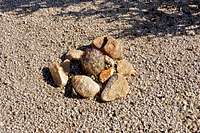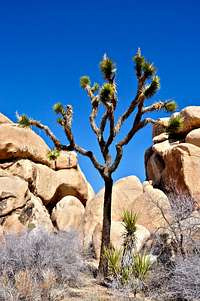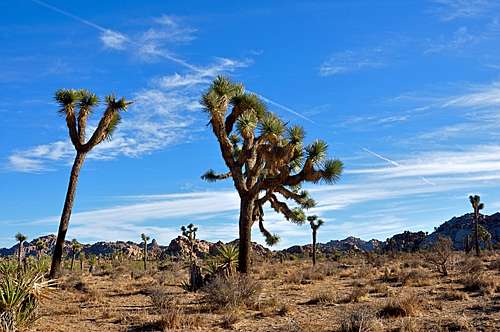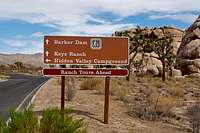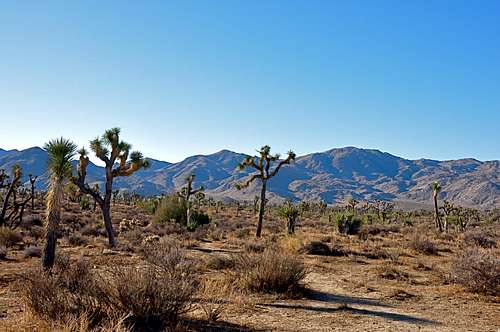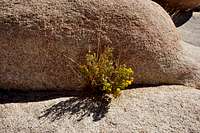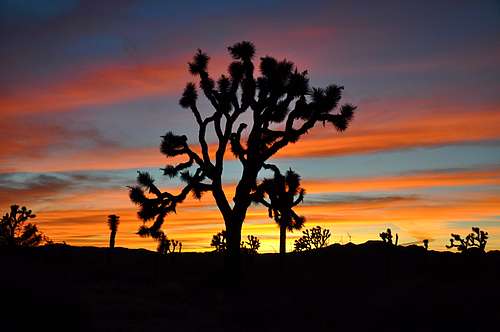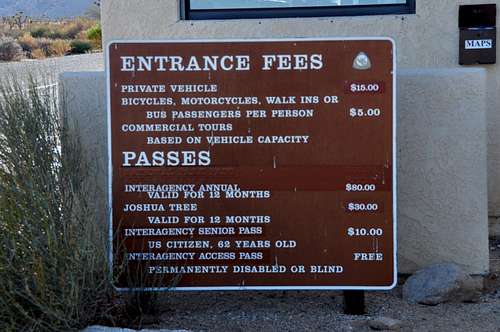-
 6657 Hits
6657 Hits
-
 86.85% Score
86.85% Score
-
 23 Votes
23 Votes
|
|
Mountain/Rock |
|---|---|
|
|
34.02215°N / 116.16064°W |
|
|
Riverside |
|
|
Trad Climbing |
|
|
Spring, Summer, Fall, Winter |
|
|
4210 ft / 1283 m |
|
|
Overview
Peyote Cracks is the name of a rock formation in Joshua Tree National Park, California. This singularly independent formation, and not a part of family of rocks, is some 250 yards northeast of Rock Hudson and a few hundred yards directly west of South Face of Echo Cove.The name Peyote Cracks evokes scenarios as to why this formation was named as such. Feel free to let your imagination run wild. In any event, I cannot think of any area in the U.S.A. that offers such a vast variety of rock formations as Joshua Tree National Park. You can find face climbs and crack climbs for all abilities with the easiest approaches. Peyote Cracks is one such case. Although the climbs here are not for the very beginners, they are well within the reach of most climbers. And, if you are good enough to think that the climbs of the west face are too boring, all you need to do is to go around to back side of the same rock and knock yourself out.
This formation, simply known as Peyote Cracks, is a single pitch height rock that is long and narrow with, more or less, north south orientation. The west face offers several crack systems ranging in difficulty levels from 5.8 to 10a. There is one route on the extreme left side by the name,Button Soup, that wanders up the rock with a much lower difficulty rating of 5.2. There are also some poorly protected face routes on the right side of the west face that offer a greater challenge for better climbers. To the right of the Right Peyote Crack there is a face route, Face It, rated 10a that has long been a top rope problem. If you feel comfortable on clipping only one bolt and running it out, you can try leading it. I prefer to top rope this one. There is another well-bolted route to the right and around the corner from Face It. Unfortunately, I have no information on the name or the difficulty of this climb.
The main attractions of the west face, however, are the Peyote Cracks, Left Peyote Crack, 10b, Middle Peyote Crack, 5.9, and Right Peyote Crack, 5.8. These three crack systems are true Joshua Tree classics for the up and coming climbers. If you don't feel like leading any of the routes, you can scramble to the top to set up top rope via the low angle shoulder on the south end of the formation. Typical to all Joshua Tree cracks, Peyote Cracks are rough on the inside. Don't forget to tape.
Routes
Select routes of West Face of Peyote Cracks | |
| A | Button Soup, 5.2, standard rack |
| B | Left Peyote Crack, 10b, Standard Rack |
| C | Middle Peyote Crack, 5.9, Standard Rack |
| D | Right Peyote Crack, 5.8, standard rack |
| E | Face It, 10a, toprope, 1 bolt |
South End
Getting There
From the western entrance to Joshua Tree National Park drive on Park Boulevard, formerly known as Quail Springs Road, for about nine miles to a major rock formation called “Intersection Rock.” Intersection Rock is a major landmark on the north side of Quail Springs Road with ample parking for visitors and climbers alike. This rock, true to its name, sit at the cross roads to “Hidden Valley Campground”, Barker Dam Road and the road to “Day use and picnic” area.Just past Intersection Rock, take the road to Barker Dam for a short distance. Shortly after getting on this road you’ll see a sign for “Key’s Ranch” Road. Take this dirt road to a large parking area on the right. Just beyond the parking area there is a sign for “Key’s Ranch Guided Tours.” You can drive further on this road to access several other climbing formations, but you will run into a locked gate for “Key’s Ranch.” Walk along the dirt road and within less than a minute the South Face Of Echo Cove will be on your right, and right next to the road. Continue walking along the road to the end of the south face where you will see another small parking area. Looking in the direction of the west, you will see a long and not particularly long formation a few hundred yards away. That is Peyote Cracks formation and you are looking at it's east face. To get to the west face go around from the left, south end, to get to the west face.
Camping, noise considerations, Environmental concerns, Fees & Food
Please tread lightly. The Access Fund has gone to great lengths posting trail marker for approaches to many of the more popular crags. Do your best to stay on these trails, and where you are forced to use a different path, choose the ones that rain can mend in time. Drainages make for good trails where there are no established trails.
Avoid stepping on native and fragile plants, and do not feed the coyotes. Coyotes are very much used to people and often hang around picnic areas and camp grounds in hopes of getting a hand out. It’s better to let them live their natural life.
Camping
There are nine campgrounds in Joshua Tree National Park. At the entrance to the park you are always asked if you would care to have a map and a brochure. The brochure will have plenty of information on the campgrounds and the map will guide you to many of the pleasant hikes throughout the park. You may even get the latest information as to availability of campsites. During the peak season (mid winter through spring) finding a campsite may become a major task. It is highly recommended to use the following link to get more information in advance.
Joshua Tree Camping
Noise considerations
When you are camping with friends and sitting around the fire, it is easy to forget that there are other people trying to sleep in the nearby campsites. It is important to put yourself in their shoes. Keep the noise and music to a minimum and certainly not too much past 10 p.m. Your neighbors will smile at you in the morning instead of giving you dirty looks.
Fees and Food
My wife and I have had Thai food in many different restaurants and cities. This Thai place beats them all. In November when the number of visitors to Joshua Tree reaches its peak, this restaurant puts on a Thai buffet, all you can eat for 10.95$/person. But, you must get there early, or be prepared to wait by the door for a table. The latest information indicates that the buffet style will be terminated by the end of February and will resume in November of 2010.



